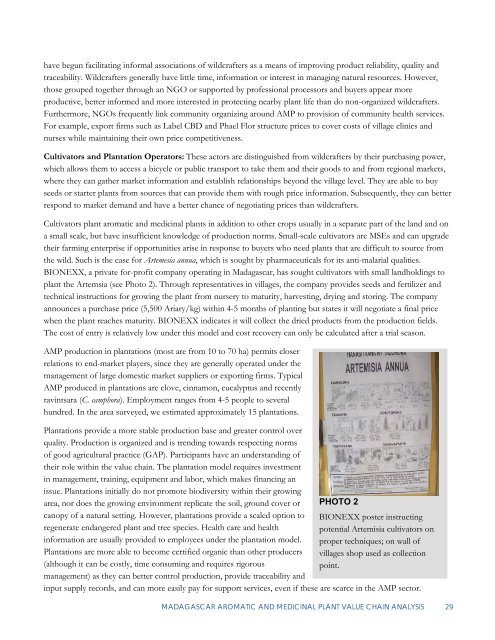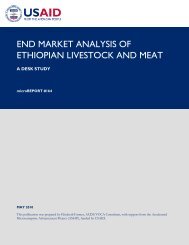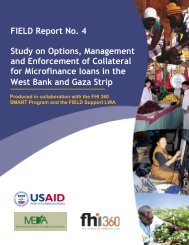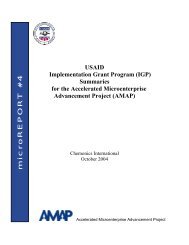Madagascar Aromatic and Medicinal Plants Value - Microlinks
Madagascar Aromatic and Medicinal Plants Value - Microlinks
Madagascar Aromatic and Medicinal Plants Value - Microlinks
You also want an ePaper? Increase the reach of your titles
YUMPU automatically turns print PDFs into web optimized ePapers that Google loves.
have begun facilitating informal associations of wildcrafters as a means of improving product reliability, quality <strong>and</strong><br />
traceability. Wildcrafters generally have little time, information or interest in managing natural resources. However,<br />
those grouped together through an NGO or supported by professional processors <strong>and</strong> buyers appear more<br />
productive, better informed <strong>and</strong> more interested in protecting nearby plant life than do non-organized wildcrafters.<br />
Furthermore, NGOs frequently link community organizing around AMP to provision of community health services.<br />
For example, export firms such as Label CBD <strong>and</strong> Phael Flor structure prices to cover costs of village clinics <strong>and</strong><br />
nurses while maintaining their own price competitiveness.<br />
Cultivators <strong>and</strong> Plantation Operators: These actors are distinguished from wildcrafters by their purchasing power,<br />
which allows them to access a bicycle or public transport to take them <strong>and</strong> their goods to <strong>and</strong> from regional markets,<br />
where they can gather market information <strong>and</strong> establish relationships beyond the village level. They are able to buy<br />
seeds or starter plants from sources that can provide them with rough price information. Subsequently, they can better<br />
respond to market dem<strong>and</strong> <strong>and</strong> have a better chance of negotiating prices than wildcrafters.<br />
Cultivators plant aromatic <strong>and</strong> medicinal plants in addition to other crops usually in a separate part of the l<strong>and</strong> <strong>and</strong> on<br />
a small scale, but have insufficient knowledge of production norms. Small-scale cultivators are MSEs <strong>and</strong> can upgrade<br />
their farming enterprise if opportunities arise in response to buyers who need plants that are difficult to source from<br />
the wild. Such is the case for Artemesia annua, which is sought by pharmaceuticals for its anti-malarial qualities.<br />
BIONEXX, a private for-profit company operating in <strong>Madagascar</strong>, has sought cultivators with small l<strong>and</strong>holdings to<br />
plant the Artemsia (see Photo 2). Through representatives in villages, the company provides seeds <strong>and</strong> fertilizer <strong>and</strong><br />
technical instructions for growing the plant from nursery to maturity, harvesting, drying <strong>and</strong> storing. The company<br />
announces a purchase price (5,500 Ariary/kg) within 4-5 months of planting but states it will negotiate a final price<br />
when the plant reaches maturity. BIONEXX indicates it will collect the dried products from the production fields.<br />
The cost of entry is relatively low under this model <strong>and</strong> cost recovery can only be calculated after a trial season.<br />
AMP production in plantations (most are from 10 to 70 ha) permits closer<br />
relations to end-market players, since they are generally operated under the<br />
management of large domestic market suppliers or exporting firms. Typical<br />
AMP produced in plantations are clove, cinnamon, eucalyptus <strong>and</strong> recently<br />
ravintsara (C. camphora). Employment ranges from 4-5 people to several<br />
hundred. In the area surveyed, we estimated approximately 15 plantations.<br />
Plantations provide a more stable production base <strong>and</strong> greater control over<br />
quality. Production is organized <strong>and</strong> is trending towards respecting norms<br />
of good agricultural practice (GAP). Participants have an underst<strong>and</strong>ing of<br />
their role within the value chain. The plantation model requires investment<br />
in management, training, equipment <strong>and</strong> labor, which makes financing an<br />
issue. Plantations initially do not promote biodiversity within their growing<br />
area, nor does the growing environment replicate the soil, ground cover or<br />
canopy of a natural setting. However, plantations provide a scaled option to<br />
regenerate endangered plant <strong>and</strong> tree species. Health care <strong>and</strong> health<br />
information are usually provided to employees under the plantation model.<br />
Plantations are more able to become certified organic than other producers<br />
(although it can be costly, time consuming <strong>and</strong> requires rigorous<br />
management) as they can better control production, provide traceability <strong>and</strong><br />
PHOTO 2<br />
BIONEXX poster instructing<br />
potential Artemisia cultivators on<br />
proper techniques; on wall of<br />
villages shop used as collection<br />
point.<br />
input supply records, <strong>and</strong> can more easily pay for support services, even if these are scarce in the AMP sector.<br />
MADAGASCAR AROMATIC AND MEDICINAL PLANT VALUE CHAIN ANALYSIS 29





